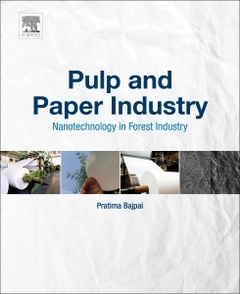Description
Pulp and Paper Industry
Nanotechnology in Forest Industry
Author: Bajpai Pratima
Language: English
Subjects for Pulp and Paper Industry:
Keywords
Active nanocellulose; Agglomeration; Agricultural crops; Algae; Animal cellulose; Automotive; Bacterial cellulose; Biobased material; Biodegradable; Biomedical; Building and construction; Cellulose nanocrystals (CNC)Commercialization; Cellulose; Challenges; Characterization; Chemical delignification; Chemical method; Composites; Consumer; Cosmetics; Cryo-crushing; Crystalline structure; Degree of crystallinity; Degree of polymerization (DP)Microscopy characterization; Diagnostics; Electronic and optoelectronic devices and surface coating; Electrospinning; Energy; Environmental effects; Environmental fate; Enzymatic method; Foams and aerogels; Food; Forest sector; Forest-based economy; Genetically modified algae; Grinding; High-pressure homogenization; Hygiene and absorbent products; Industrial application; Innovation; Legislation; Lignocellulosics; Living organism; Microscale; Morphology; Nanocel carboxylated NCC; Nanocellulose film; Nanocellulose production; Nanocellulose; Nanofibrillated cellulose film; Nanoscale; Nanotechnology; New functionalities; NFC; Opportunities; Packaging application; Paints; Paper and board; Paper mill sludge; Paper; Physical and chemical properties; Physical characterization; Pilot-scale method; Precommercial plant; Preparation; Printed electronics; Production; Properties; Pulp; Raw material; Refining; Roll-to-roll production; Semicommercial; Sensors; Standard; Steam explosion; Structure; Surface area measurements; Surface modification; Surface properties; Suspension properties; TEMPO NC; Textile; Toxicity; Tunicates; Water purification; Wood composites; Wood
Support: Print on demand
Description
/li>Contents
/li>Readership
/li>Biography
/li>Comment
/li>
Pulp and Paper Industry: Nanotechnology in Forest Industry covers the latest scientific and technical advances in the area of nanotechnology in forest sector providing information on recent developments, structure and properties, raw materials and methods for the production of nanocellulose along with their characterization and application in various industries with an analysis of both challenges and opportunities with respect to environmentally sound technologies and consumer concerns such as health effects. Also identifies the key barriers to innovation, and the breakthroughs required to make nanocellulosic materials viable alternatives in the important sectors.
Chapter 1. Introduction
Chapter 2. Raw Materials for Production of Nanocellulose
Chapter 3. Structure and Properties of Cellulose and Nanocellulose
Chapter 4. Production of Nanocellulose
Chapter 5. Preparation and Properties of Nanocellulose Films
Chapter 6. Characterization of Nanocellulose
Chapter 7. Modification of Nanocellulose to Improve Properties
Chapter 8. Applications
Chapter 9. Commercialization Activities
Chapter 10. Environmental and Human Health Risks
Chapter 11. Challenges and Opportunities
This book will be a valuable resource for Foresters, Material Scientists, Pulp and Paper Technologist/ Engineers, Senior Paper Scientists, Applied Chemists, Chemical Engineers, Professionals, Academics, Analysts, Consultants
- Thorough review of the evolution and development of different types of nanocelluloses
- In-depth coverage of preparation and characterization of nanocellulose
- Use of nanocellulose materials in a wide range of applications
- Commercial and precommercial developments
- Challenges and opportunities of nanocellulose market
- Identifies the key barriers to innovation, and the breakthroughs required to make nanocellulosic materials viable alternatives in the important sectors
These books may interest you

Pulp and Paper IndustryChemicals 137.79 €



